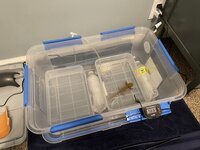elliot7rrr
New member
Okay so please don’t hate on me way too hard. I had been interested in being an axolotl momma for ages, and then I was at the pet store getting dog food and they had them and I just kind of went for it. No prior preparation - I just pulled the trigger. I realize now that I should’ve had a fully cycled tank - and a lot more knowledge - established prior to bringing him home.
So I have a lot questions now about how I can do better moving forward.
The current tank setup is a 10-gallon (he’s a juvenile and I do intend to upgrade to a larger tank in a few months) with a Tetra Whisper filter (for 5-10gal tanks) at one end and an air stone at the other end. He has a large ceramic mug for a hide. I added a couple of mystery snails when algae growth was getting out of control. They don’t bother him and he’s not bothered them. They’re too big to fit in his mouth at this point so I’m not concerned about that. I don’t have any substrate as I was concerned about the potential for him to ingest it.
First question: I haven’t read much about anyone using air stones on here. Should I not be using an air stone?
As far as feeding goes, he’s eating really well. Primarily frozen brine shrimp and I give frozen blood worms as well but I try to give more shrimp than blood worms since I read that the nutritional value of the shrimp is much better for him and blood worms are more of a treat. I feed him those frozen cubes, and he likes to bite at them right out of my fingers as they thaw until it’s small enough for him to eat the entire remainder. So,
Second question: does anyone else hand feed their axolotl? Does doing this pose any risks to him? Obviously he misses and bites me a lot but it doesn’t hurt so I don’t care - I just see it as bonding time. But now I’m wondering if it’s safe for him.
I’ve been testing the Ph and it’s been holding steady around 7.6. Until yesterday, I knew absolutely nothing about ammonia, nitrates, and nitrites, so I’m planning to go get test kits and such related to that today.
Last question: Can someone please give me a crash course on ammonia, nitrates, and nitrites as well as what supplies I need in order to test for and address issues with them? I’m lost. I’ve been doing a ton of reading but I’m struggling to understand the science here. For supplies recommendations, I’m located in the US.
Please nobody panic. He really is doing well. He’s eating like a champ and doesn’t seem to be very stressed. I know I messed up by getting into this with so little knowledge, but I hope you can understand that I’m a person and I make mistakes and I’m just trying to be responsible now.
So I have a lot questions now about how I can do better moving forward.
The current tank setup is a 10-gallon (he’s a juvenile and I do intend to upgrade to a larger tank in a few months) with a Tetra Whisper filter (for 5-10gal tanks) at one end and an air stone at the other end. He has a large ceramic mug for a hide. I added a couple of mystery snails when algae growth was getting out of control. They don’t bother him and he’s not bothered them. They’re too big to fit in his mouth at this point so I’m not concerned about that. I don’t have any substrate as I was concerned about the potential for him to ingest it.
First question: I haven’t read much about anyone using air stones on here. Should I not be using an air stone?
As far as feeding goes, he’s eating really well. Primarily frozen brine shrimp and I give frozen blood worms as well but I try to give more shrimp than blood worms since I read that the nutritional value of the shrimp is much better for him and blood worms are more of a treat. I feed him those frozen cubes, and he likes to bite at them right out of my fingers as they thaw until it’s small enough for him to eat the entire remainder. So,
Second question: does anyone else hand feed their axolotl? Does doing this pose any risks to him? Obviously he misses and bites me a lot but it doesn’t hurt so I don’t care - I just see it as bonding time. But now I’m wondering if it’s safe for him.
I’ve been testing the Ph and it’s been holding steady around 7.6. Until yesterday, I knew absolutely nothing about ammonia, nitrates, and nitrites, so I’m planning to go get test kits and such related to that today.
Last question: Can someone please give me a crash course on ammonia, nitrates, and nitrites as well as what supplies I need in order to test for and address issues with them? I’m lost. I’ve been doing a ton of reading but I’m struggling to understand the science here. For supplies recommendations, I’m located in the US.
Please nobody panic. He really is doing well. He’s eating like a champ and doesn’t seem to be very stressed. I know I messed up by getting into this with so little knowledge, but I hope you can understand that I’m a person and I make mistakes and I’m just trying to be responsible now.

